
2010 BoXXer Long Term Review
Late last fall I started testing a 2010 Rock Shox BoXXer World Cup fork. I have had lots of experience with the BoXXers over the years. I used to run a 2006 World Cup and most recently a 2008 – which like the 2010 were both air sprung. The main attraction for me is the high performance at a pound less than the competition. The problem with earlier generations was the amount of maintenance required to keep them working well. I have heard it said more times than I can remember, “ this is a competition fork so it requires more maintenance.” I accepted that but still secretly wished I could ride a light, high performance fork without the expense and hassle of regular oil changes, rebuilds and o-ring swaps etc. These trips to the bike shop are more painful when you remember the pile of cash you spent on the fork in the first place.
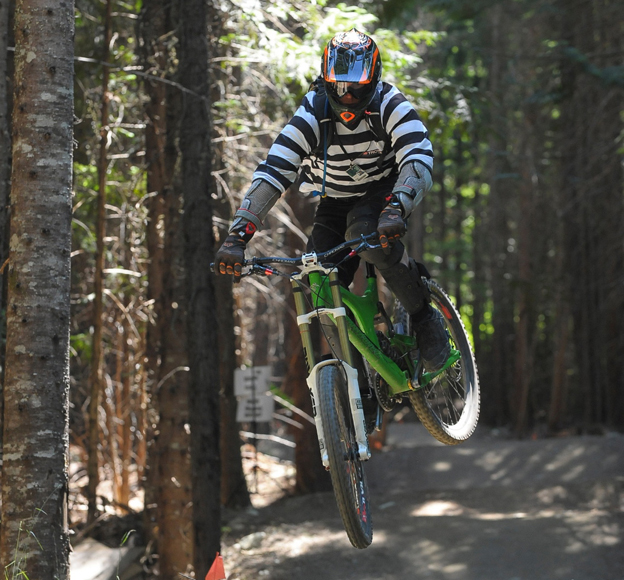
Much of Mike’s testing was done in the Whistler Bike Park.
When I started testing this fork I was really hoping this new version had a more consistent feeling than the previous version. My 2008 always felt awesome after a rebuild and fresh oil but quickly lost the love after a few rides. 

Travel on the 2010 Boxxer World Cup is 200 mm or 7.9 inches. Uppers are 35 mm, 7000 series aluminum and lowers are magnesium. The axle is a 20mm Maxle Lite. Of course, on the World Cup the spring is air and is called the long travel Solo Air assembly.
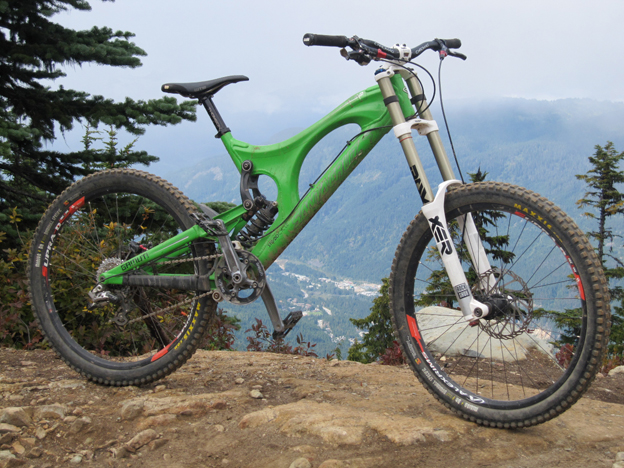
Trust me – it’s a World Cup. Mike took the fork in to be overhauled at the Rock Shox tent in Whistler (posing as Joe Public rather than a tester) and the fork came back with new lowers – but no rainbows. Photo ~ Mike Wallace
We weighed the fork at Steed Cycles and it came in at 5.9 lbs or 2675 grams. This is 0.3 lbs/136 grams less than a 2009 Boxxer World Cup we weighed and more than 0.7 lbs/317 grams less than a 2010 Boxxer Team. It is no wonder SRAM has put so much effort into designing and manufacturing an air fork; it’s fricking light.
Adjustments on the fork include air spring pressure, high speed compression, low speed compression, beginning stroke rebound, ending stroke rebound and bottom out. I found that I have spent much more time playing with the adjustments on this fork than any other fork I have used. It took me awhile to get the feel just right under different conditions. The good news is that the adjustments actually work and make a significant difference. I think on previous forks I would eventually give up trying to make major changes other than the usual spring rate tweaks. 

When I first set the fork up I started out with the rebound adjustments near the center of the range and high and low speed compression set to zero. I weigh 170 lbs so I started at 70 lbs of air pressure as per the online guide. On the 2008 version I found I like it best when it was set up linear with no added compression. Things turned out a little differently with the 2010. What I found was that in order to improve the small bump sensitivity I had to lower the air pressure down to as low as 55 – 60 lbs. However when I did that then I found the front end was diving on big compressions or g-outs so common on the North Shore. Actually, where I first figured this out was on one of the steep ladder bridges to gnar on Shore Play – a trail on Cypress. The diving was basically eliminated by adding 1 turn of low speed compression (max is 4 turns) and 2-3 clicks of high speed compression. During all of this I had the bottom out completely turned on which means the air chamber was in its lowest volume setting.
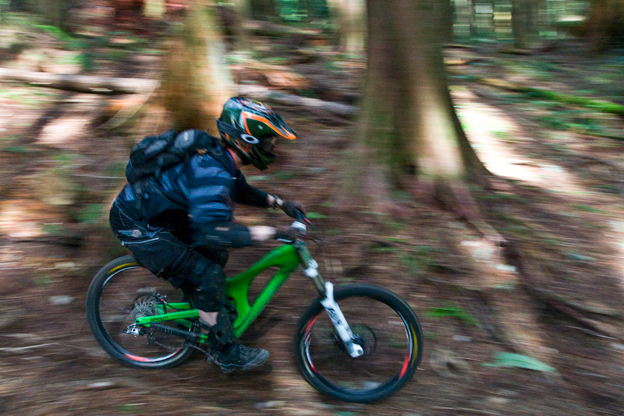
Mike testing on the trail that used to be called Bobsled. It’s still called Bobsled but it no longer looks like this. Instead it looks like it was ripped out of the Silver Star Bike Park – and the name now fits the trail perfectly. Photo ~ Cam McRae
This set up worked well for me until the Whistler bike park opened for the year. What I learned that first weekend in the park is that the old North Shore guidelines of slower rebound being better don’t cut it anymore with these more tunable forks. I found the fork was packing up on the high speed rough stuff and the harshness was making me wish I was sitting on the chairlift. I was able to improve this small bump performance by increasing the beginning stroke rebound. The online manual says there are 24 clicks of beginning stroke rebound. I was never able to feel the clicks (which I hope is fixed for 2011) but I turned the knob to about 75% towards the faster side. I understand the beginning and ending stroke rebound mechanisms affect each other so I also increased the ending stroke rebound.

I also tried opening up the bottom out to get a more linear feel and potentially better small bump compliance, but it didn’t help. I definitely preferred the more progressive feel of having the bottom out completely on as the fork handled the big hits better. I talked to lots of riders at Whistler over the summer and most rode the fork with the bottom out completely on.
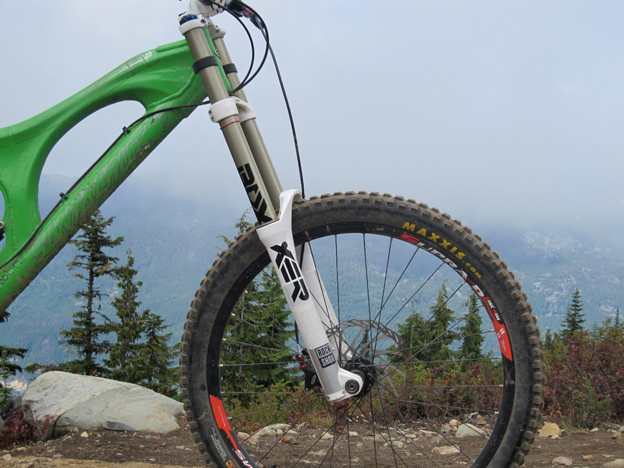
Well matched. Just like Steve Peat, Mike likes having the BoXXer World Cup on the front of his Steed Cycles-green Santa Cruz V10. Photo ~ Mike Wallace
I made a lot of changes to try and improve the small bump suppleness but was never able to get it to the point where I was really happy. Stiction can be an issue when working on small bump performance and the SRAM folks (during Crankworx) went over the fork to make sure all was good. I talked to several DH racers during Crankworx about the small bump compliance but none of them really cared. To the racer crowd it is all about lightness, stiffness and the ability to soak up the medium to big hits at speed.
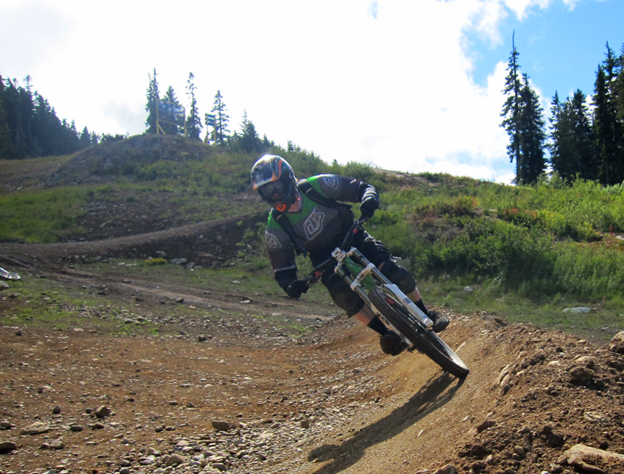
Bermalicious. Photo ~ Trevor Hansen.
This fork tracks very well. This is likely a result of the increased stiffness provided by the larger diameter upper tubes (35mm compared to 32 mm on my 2008 Boxxer). I ride a Santa Cruz V10 which is a point and shoot type of bike but I could still feel the added stiffness. For example on Whistler near the top of Rock City there is a ladder bridge drop to rocky tree threading section and I felt more in control than with the earlier version of the World Cup. I was able to direct the bike towards the opening in the trees and ride through without the usual feeling of being knocked around.
Another obvious improvement over the previous generation of Boxxers is the new Maxle. On my 2008 Boxxers I lived in fear of getting a front flat on the trail because the DH-Maxle was such a pain to get out as it became worn. I often had to use a rubber mallet in the shop to get the wedge to come loose. The new Maxle Lite DH has been much better with the internals being more defined and responsive to the allen key turns.

Shore laps require one set of settings while the Whistler Bike Park asks for something else. Photo ~ Cam McRae
I am very happy to report that the durability of this fork has been much better than my 2008 World Cup. The fork still felt good after lots of days at Whistler, Silver Star and on the Shore. Whister did eventually take its toll on the fork’s plushness and I had it overhauled during Crankworx by the Rock Shox service crew in the SRAM tent.

Required ass shot. Photo ~ Cam McRae
The wet climate of the Shore used to be the number one fork killer for me. Nowadays I would say the quickest way to punish your fork in BC is to ride in the gritty dust of the Okanagan bike parks. This fork has now been through all of this with the seals still working like new.

So the new generation of Boxxers is light, stiff and very adjustable. Everything you want if you are a DH racer. For the serious weekend warrior this fork is much better choice than the previous version (2009 model) due to the improved dependability and increased time between oil changes. The two negatives in my mind are the lack of suppleness on the small high-speed braking bumps and of course the up front cost which has always been high for the World Cup model. Especially when compared to the price of the Boxxer Team (the Team and Race designations are gone and for 2011 you’ll choose between RC, RC2 and World Cup). You have to ask yourself how much it’s worth to lighten your bike.
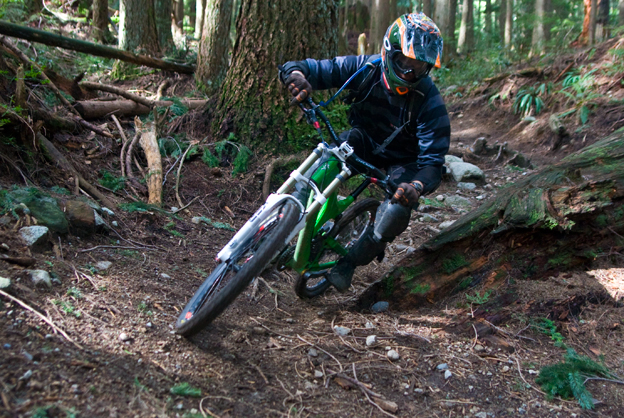
Somehow Rock Shox made the 2010 BoXXer lighter and stiffer than the previous model. Photo ~ Cam McRae
For 2011, the Boxxer World Cup looks identical from a distance. However there are external changes including new adjuster knobs, top and bottom, and new sag markers on the stanchion. Internally the 2011 gets a retuned Mission Control DH damper and a new more compact Solo Air Spring. The new Maxle Lite is reported to be lighter and stiffer. The fork will be available in black, red and white – and I will be installing a red one shortly to tell you how it feels.
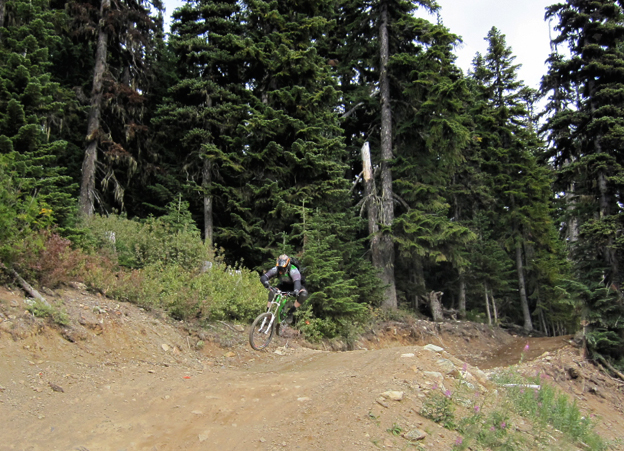
Lighter fork = more air? Maybe so. Photo ~ Trevor Hansen.
Pros:
– The lightest DH fork on the planet
– Torsionally stiff despite its lack of heft
– Highly tunable
Cons
– Lack of small bump compliance
– Somewhat pricy
2011 Boxxer Pricing in USD
BoXXer RC – Coil, 200mm, Maxle DH, Black, Motion Control IS, Alum Steerer 1 1/8″ (includes – tall and short crowns, 2 tuning springs) MSRP USD $795
BoXXer R2C2 – Coil, 200mm, Maxle DH, Black, Mission Control DH, Alum Steerer 1 1/8″ (includes – tall and short crowns, 2 tuning springs) MSRP USD $1,180
BoXXer World Cup – Solo Air, 200mm, Maxle DH, Red, Mission Control DH, Alum Steerer 1 1/8″ (includes – tall and short crowns, pump) MSRP USD $1,700
Are you thinking about strapping an air spring to the front of your sled? Not ready for the commitment? Share your experiences here…







Comments
Please log in to leave a comment.